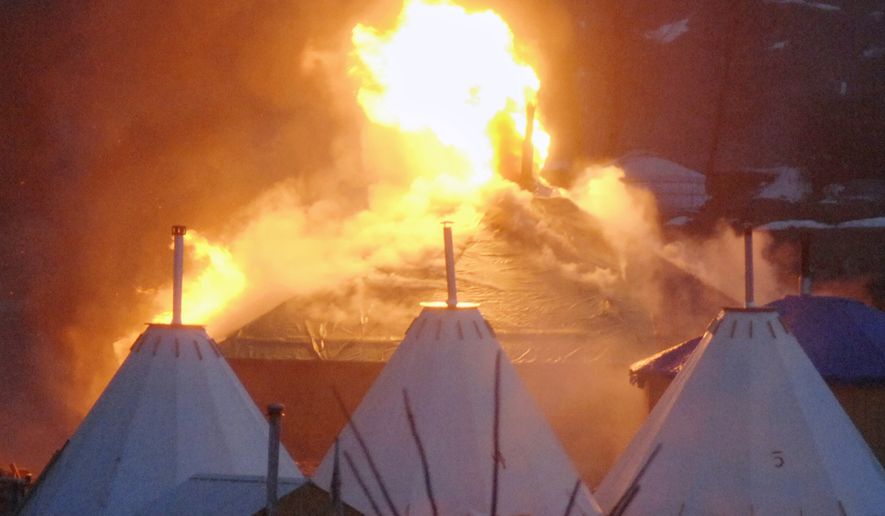Two children were burned, one of them severely, at the Dakota Access camp evacuation Wednesday after remaining activists set fire to about 20 shelters and a vehicle in what was described as a departure ceremony.
North Dakota Gov. Doug Burgum said a 17-year-old girl was airlifted to a hospital in Minneapolis, and that a seven-year-old boy was also hurt as most of the activists left the camp in compliance with a U.S. Army Corps of Engineers eviction order.
Most of those remaining at the camp left peacefully, but 10 protesters were arrested after making their way onto Highway 1806 and refusing to disperse.
“In the intentional burning of some of the buildings, which may have been ceremonial in nature … there was apparently either a fire out of control or an explosion,” said Mr. Burgum at a livestream press conference after the evacuation. “There was a 17-year-old woman who was severely burned.”
The North Dakota Joint Information Center reported at least two explosions at the Oceti Sakowin camp, the largest of the pipeline protest camps located on federal land in a floodplain near Cannon Ball, North Dakota.
“We’re sharing that because obviously it’s very sad for all the people involved,” the Republican governor said.
SEE ALSO: Most oil pipeline opponents leave North Dakota protest camp
Those arrested were charged with obstructing a government function, which is a misdemeanor, bringing the total number of arrests since August to about 720, said Morton County Sheriff Kyle Kirchmeier.
Mr. Burgum said that those who were arrested “really had to be trying to get it done.”
“For someone to be arrested on the road today, they had to have interaction with law enforcement within the arrest zone with the intention of being arrested,” Mr. Burgum said. “In the true North Dakota way, they had every opportunity to walk away and not be arrested. So this is clearly a case where to be arrested today you really had to be trying to get it done because that was not part of our operational plan.”
While most of the remaining 200-300 protesters exited the camp, some aided by free travel, food and hotel vouchers from the state, as many as 50 people remain, the smallest number since protest activity against the pipeline kicked into high gear in August.
Those people have been asked to leave by 9 a.m. Thursday so that the clean-up effort can resume, an enormous project that has taken on new urgency as water in the floodplain on federal land continues to rise.
“Anyone who wants to voluntarily leave will be allowed to leave,” Mr. Burgum said. “As we come in and do cleanup tomorrow morning, anybody that’s there is trespassing, so anybody that’s there is breaking the law. Anyone who obstructs our ability to do cleanup will be subject to arrest.”
Protesters left behind tons of garbage and debris at the camps after clearing out in the aftermath of an early December blizzard. The tribe, state and corps are coordinating to return the prairie to its pre-protest condition.
As many as 300 vehicles were also abandoned, raising concerns about engine leaks that may have contaminated the soil, the governor said.
“This isn’t just little kids picking up garbage in a ditch along the road,” said Mr. Burgum. “There’s work to do to actually return this land to its state. And it’s again right in the watershed of both the Cannonball River and the Missouri River. So there’s plenty of work to do by the corps on professional remediation after buildings and garbage have been removed.”
He said law enforcement officers observed the evacuation from the highway but did not enter the camp.
Two checkpoints manned by state and federal agencies, including the Bureau of Indian Affairs and the North Dakota Highway Patrol, have been set up to make sure protesters who leave the camp cannot return.
“The whole idea is to keep people out,” said Sen. John Hoeven, North Dakota Republican. “We’ve got a limited amount of time here, folks. We’ve got to clean this up.”
The protest, which drew thousands to rural south-central North Dakota, was aimed at stopping the 1,172-mile, four-state oil pipeline by holding up an easement for a 1,100-foot stretch under Lake Oahe.
The corps granted the easement earlier this month despite the opposition of the Standing Rock Sioux, which had raised concerns about water quality. The tribe is scheduled to appear in court Thursday in an effort to block construction.
The pipeline company has insisted the project is safe and noted that it will run adjacent to an existing natural-gas pipeline.
• Valerie Richardson can be reached at vrichardson@washingtontimes.com.




Please read our comment policy before commenting.